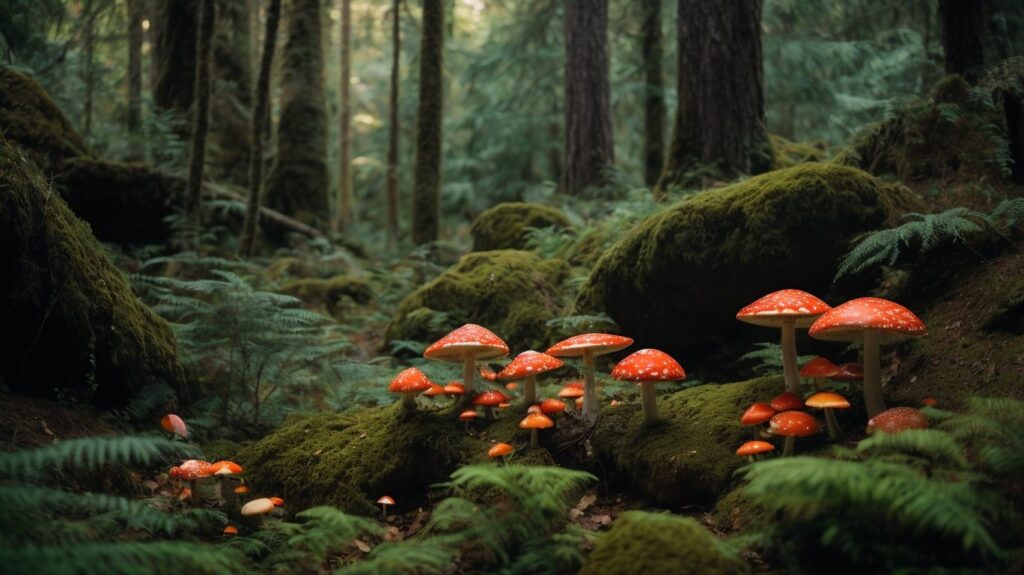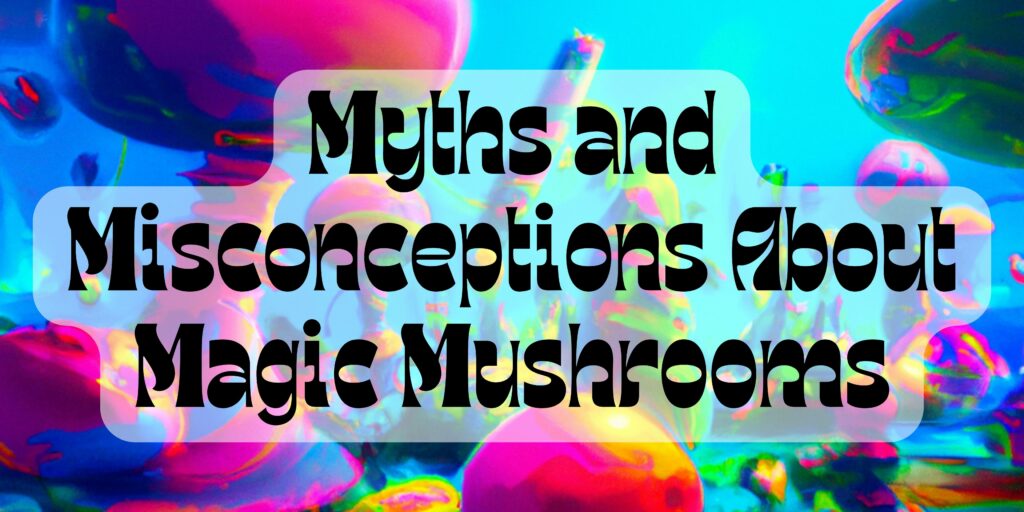Welcome to the world of psychedelic mushrooms – nature’s little wonder that has intrigued and perplexed humanity for centuries. These magic mushrooms have gained popularity in recent years, but there is still a lack of understanding about their effects on the mind and body. If you’ve ever wondered about the potential effects of shrooms, you’re not alone. Let’s dive into the intriguing world of psychedelics and explore what shrooms can do for you.
What Are Shrooms?
Shrooms, also known as magic mushrooms, are a type of fungi that contain psychedelic compounds like psilocybin and psilocin. These compounds interact with the brain’s serotonin receptors when consumed, resulting in altered perceptions, hallucinations, and mind-altering experiences.
Shrooms have a long history of use in spiritual and religious practices, as well as for recreational purposes. However, it’s crucial to note that shrooms can have unpredictable effects and may be illegal in many countries. Therefore, it’s always advisable to thoroughly research and understand the potential risks and legal implications before considering the use of shrooms.
How Do Shrooms Work?
Understanding the mechanisms of shrooms involves understanding their effects on the brain and body. Here are the steps that explain the process:
- Ingestion: Shrooms are typically consumed orally, either by eating them or brewing them into a tea.
- Chemical compounds: Psilocybin and psilocin are the main psychoactive compounds found in shrooms.
- Metabolism: Once ingested, these compounds are metabolized in the body and converted into psilocin.
- Interaction with serotonin receptors: Psilocin binds to serotonin receptors in the brain, specifically the 5-HT2A receptors.
- Effects on perception and cognition: This binding leads to altered perception, changes in mood, and altered thought processes.
- Neuroplasticity and connectivity: Shrooms may enhance neuroplasticity and promote increased connectivity between different regions of the brain.
What Are the Effects of Shrooms?
Shrooms, also known as magic mushrooms, have been used for centuries for their psychoactive properties. But what exactly are the effects of consuming these fungi? In this section, we will discuss the various effects of shrooms, including their psychological, physical, and spiritual effects. By understanding how shrooms can impact the mind, body, and spirit, we can gain a deeper understanding of their potential benefits and risks.
1. Psychological Effects
The effects on one’s psyche after consuming shrooms can differ from person to person. Here are some common psychological effects:
- Altered Perception: Shrooms can cause changes in perception of time, space, and reality.
- Enhanced Emotions: Users may experience intense emotions, both positive and negative.
- Visual and Auditory Hallucinations: Shrooms can induce vivid visuals and auditory distortions.
- Increased Introspection: Users may engage in deep self-reflection and introspective thinking.
- Ego Dissolution: Some individuals report a loss of sense of self and unity with the universe.
It’s important to keep in mind that the psychological effects of shrooms can be unpredictable and influenced by various factors, such as dosage, set and setting, and individual susceptibility.
Buckle up, because shrooms are about to take you on a wild ride through changes in perception, body temperature, and even muscle spasms – it’s like a fun house in your brain.
2. Physical Effects
When consuming shrooms, there are various physical effects that can manifest. These effects are a result of the chemical compounds in the mushrooms interacting with the body.
- Increased heart rate and blood pressure
- Dilated pupils
- Changes in body temperature and sweating
- Loss of coordination and balance
- Nausea and vomiting
- Increased sensory perception
- Heightened energy levels
- Increased reflexes
It is important to note that these physical effects can vary from person to person and can be influenced by factors such as dosage, individual tolerance, and set and setting.
3. Spiritual Effects
The consumption of shrooms can lead to various spiritual effects, which can be both profound and transformative.
- Increased connectedness: Many individuals report feeling a deep sense of connection to the universe, nature, and other beings.
- Enhanced introspection: Shrooms can facilitate introspective experiences, leading to deep self-reflection and insights.
- Heightened perception: Some users describe experiencing an amplified perception of their surroundings, with colors appearing more vibrant and sensory perception heightened.
- Spiritual awakening: Shrooms have been known to induce mystical experiences, leaving users with a sense of awe, wonder, and a feeling of being connected to something greater than themselves.
- Expanded consciousness: Users often describe a shift in consciousness, allowing them to explore different realms of existence and gain a broader understanding of reality.
When consuming shrooms for spiritual purposes, it is crucial to approach the experience with intention, create a safe and comfortable setting, and have a trusted guide or sitter to support you throughout the journey.
Just like taking a selfie with a tiger, using shrooms comes with its own set of risks. And trust me, you don’t want to end up with a bad trip or accidental poisoning.
What Are the Risks of Using Shrooms?
While the use of shrooms, or magic mushrooms, has gained popularity in recent years for their potential therapeutic benefits, it is important to understand the potential risks involved. In this section, we will discuss the various risks of using shrooms, including the possibility of experiencing a bad trip, the potential for flashbacks, and the danger of accidental poisoning. By being aware of these risks, individuals can make informed decisions about their use of shrooms and take necessary precautions to ensure their safety.
1. Bad Trips
A negative experience while using shrooms can be distressing, but there are steps you can take to minimize the risk:
- Set and Setting: Choose a comfortable and safe environment.
- Start with a Low Dose: Begin with a small amount to gauge your reaction.
- Have a Trip Sitter: Have a trusted person present to offer support.
- Maintain a Positive Mindset: Focus on positive thoughts and emotions.
- Engage in Distractions: Listen to calming music or engage in activities that bring joy.
Fact: Studies have shown that the majority of people who use shrooms do not experience bad trips and report positive and transformative experiences instead.
2. Flashbacks
Flashbacks are a potential risk associated with using shrooms. These are recurring hallucinatory experiences that can happen even after the effects of the drug have worn off. While not everyone who uses shrooms will experience flashbacks, it is important to be aware of their possibility.
To minimize the risk of flashbacks, consider the following steps:
- Start with a low dose: Taking a smaller amount of shrooms reduces the likelihood of intense experiences and potential flashbacks.
- Have a trip sitter: Having a trusted person present during your trip can provide support and help manage any unexpected reactions, including flashbacks.
- Know the source of your shrooms: Obtaining shrooms from a reliable and trustworthy source reduces the risk of consuming contaminated or unsafe products, which can lead to flashbacks.
Forget poison ivy, accidental shroom ingestion is the real danger of nature hikes.
3. Accidental Poisoning
Accidental poisoning is a potential risk when using shrooms. To avoid this, it is important to take the following precautions:
- Identify the correct species: Make sure you can accurately identify the type of mushroom you plan to consume to prevent ingesting a toxic variety.
- Consult an expert: Seek guidance from an experienced mycologist or mushroom foraging expert who can assist you in identifying safe species and provide advice on safe consumption.
- Do thorough research: Educate yourself about the toxic mushrooms that may resemble edible ones to avoid unintentional ingestion.
- Never forage alone: Always go mushroom hunting with someone who is knowledgeable about mushroom identification and can offer assistance in case of an emergency.
- Start with small amounts: If you are trying shrooms for the first time, begin with a low dose to assess your tolerance and observe any adverse reactions.
- Know the symptoms of poisoning: Familiarize yourself with the signs of mushroom poisoning and seek immediate medical attention if you experience any of them.
Don’t trip and fall, start with a low dose and have a trusted trip sitter – safety first when consuming shrooms.
How to Consume Shrooms Safely?
For those looking to try shrooms for the first time, it’s important to understand the best practices for consumption in order to have a safe and positive experience. This section will discuss the three key steps to consuming shrooms safely. First, we’ll explore the importance of starting with a low dose to gauge your tolerance. Then, we’ll discuss the benefits of having a trip sitter present to guide and support you during your journey. Lastly, we’ll touch on the importance of knowing the source of your shrooms to ensure their safety and potency.
1. Start with a Low Dose
- Begin with a small dose to assess your tolerance and sensitivity to psilocybin, the active compound in shrooms.
- Use a scale to carefully measure your dosage for accuracy.
- Consider starting with 1-1.5 grams of dried mushrooms for a gentle experience.
- Wait at least one to two hours before increasing your dose, as it may take time for the effects to fully manifest.
- Keep in mind that the potency of shrooms can vary, making it crucial to start with a low dose for a safe and controlled experience.
Fact: Starting with a low dose can minimize potential risks and allow for gradual exploration of the effects of shrooms.
Because who else will document your wild mushroom-induced revelations and inevitable dance moves?
2. Have a Trip Sitter
Having a trip sitter is a crucial safety measure when consuming shrooms. Here are some steps to follow when selecting and utilizing a trip sitter:
- Choose a reliable individual who has experience with psychedelic substances.
- Discuss expectations and boundaries with your trip sitter in advance.
- Ensure that your trip sitter is sober and in a stable mental state.
- Maintain open and honest communication during the experience.
- Allow your trip sitter to guide and support you through any difficult moments.
- Express appreciation for their presence and gratitude for their role in ensuring your safety.
True story: One user had a trip sitter who provided a calm and reassuring presence. They guided the user through an intense experience and prevented any potential harm. The trip sitter’s presence and support allowed the user to explore their thoughts and emotions in a safe and controlled environment.
3. Know the Source of Your Shrooms
When consuming shrooms, it is crucial to know the source of your mushrooms to ensure safety and quality. Here are some steps to follow:
- Research reputable suppliers or growers who practice safe cultivation methods.
- Ask for recommendations from experienced users or trusted sources.
- Look for certifications or lab testing results that verify the purity and potency of the mushrooms. This is important in knowing the source of your shrooms.
- Avoid purchasing from unknown or unreliable sources, such as street dealers or unverified online platforms.
Pro-tip: Cultivating your own mushrooms using grow kits or spore syringes can provide greater control over the sourcing and quality of your shrooms. This way, you can be sure of the source of your shrooms.
Shrooms might just be the magic mushrooms we need for treating depression, managing addiction, and unlocking our creativity – all in one trip.
What Are the Potential Therapeutic Uses of Shrooms?
While shrooms, or psilocybin mushrooms, are most commonly known for their hallucinogenic effects, recent studies have shown that they may have potential therapeutic uses as well. In this section, we will delve into the various ways shrooms may be used for therapeutic purposes. From treating depression and anxiety to managing addiction, we will explore the potential benefits of incorporating shrooms into therapeutic practices. Additionally, we will discuss how shrooms can enhance creativity and openness, offering a new perspective on these psychedelics.
1. Treating Depression and Anxiety
Treating depression and anxiety with shrooms can be a promising option, but it should be approached with caution and under the guidance of a healthcare professional. Here are some steps to consider:
- Consult a healthcare professional: Discuss your mental health concerns and explore if psilocybin therapy is suitable for you.
- Prepare for the experience: Educate yourself about the potential benefits and risks of using shrooms for depression and anxiety.
- Find a safe and supportive environment: Create a comfortable setting where you feel secure and can fully focus on your healing journey.
- Plan your dosage: Start with a low dose and gradually increase it over time, as directed by your healthcare provider.
- Integrate the experience: Reflect on your insights and emotions during and after the session with the support of therapy or integration practices.
Remember, while shrooms may offer therapeutic potential, it is crucial to approach their use responsibly and always seek professional guidance.
Who needs a support group when you have shrooms to kick your addiction?
2. Managing Addiction
- Recognize the problem: Acknowledge that you have an addiction and that it’s impacting your life negatively.
- Seek professional help: Reach out to a healthcare professional or addiction specialist who can provide guidance and support in managing addiction.
- Create a support network: Surround yourself with a strong support system of friends, family, and support groups who can help you through your journey towards managing addiction.
- Develop coping mechanisms: Learn healthy ways to cope with stress and cravings, such as engaging in physical activity, practicing mindfulness, or pursuing hobbies.
- Explore therapy options: Consider therapy modalities like cognitive-behavioral therapy (CBT) or dialectical behavior therapy (DBT) that can help address the underlying causes of addiction and aid in managing it.
- Set achievable goals: Break your journey towards managing addiction into smaller, manageable goals to stay motivated and track your progress.
Fact: Addiction is a complex condition that can be effectively managed with the right support and treatment.
3. Enhancing Creativity and Openness
Using shrooms can greatly enhance creativity and openness in individuals. If you are interested in exploring this aspect, here are a few important steps to consider:
- Set the right environment: It is crucial to create a safe and comfortable space that encourages creativity, such as a quiet room with art supplies or a peaceful outdoor setting.
- Choose the right dosage: Starting with a low dose is recommended to ensure a manageable and positive experience. Taking too high of a dose may hinder creativity and lead to overwhelming effects.
- Engage in creative activities: Shrooms may help tap into new perspectives and ideas, so it’s a great opportunity to explore artistic outlets such as painting, writing, or playing an instrument.
- Be open-minded: Embrace the altered state of consciousness that shrooms provide, allowing yourself to think outside the box and break free from creative blocks.
- Reflect and integrate: After the experience, it is important to take time to reflect on any insights gained and consider how they can be integrated into your creative process.
Frequently Asked Questions
What do shrooms do?
Shrooms, short for mushrooms, refer to the psychedelic fungi that contain the psychoactive compound psilocybin. When consumed, shrooms can alter a person’s perception, mood, and thoughts, resulting in a hallucinogenic experience.
How do shrooms affect the brain?
When consumed, psilocybin in shrooms is converted into psilocin, which mimics the effects of serotonin in the brain. This leads to changes in brain activity, resulting in altered perception, mood, and thought patterns.
What are the physical effects of shrooms?
Shrooms can cause physical effects such as dilated pupils, increased heart rate and blood pressure, nausea, and changes in body temperature. These effects are usually temporary and subside once the effects of the shrooms wear off.
What are the psychological effects of shrooms?
Shrooms can cause a range of psychological effects, including euphoria, altered perception of time and space, intensified emotions, and changes in thoughts and beliefs. These effects can vary greatly from person to person and can also depend on the dosage and environment.
Can shrooms be used for medical purposes?
Recent studies have shown that psilocybin in shrooms may have potential therapeutic benefits for mental health conditions such as depression, anxiety, and PTSD. However, further research is still needed to fully understand the potential medical uses of shrooms.
Are shrooms safe to consume?
While shrooms are generally considered safe for consumption, they can pose potential risks, especially for those with underlying mental health conditions or those who are not in a safe and controlled environment. It is also important to note that consuming shrooms is illegal in many places. If you are considering trying shrooms, it is best to do so under the guidance of a trained professional.




